Sue Burke's Blog, page 4
February 19, 2025
Three-second writing exercise

Here’s a little exercise to explore a character, possibly someone from a piece you’re working on.
Premise:
Your character is driving a car, waiting for the stoplight to change at a busy crossroads.
Your character looks in the rear-view mirror and sees a car speeding up the road behind them that will crash into them in three seconds.
What would this person think and do in those three seconds? Remember that stress slows down time, so there might be a whole lot of time.
The intent of this exercise is to get as deep into this person’s point of view as possible. How can you immerse the reader in this character’s feelings and reactions? Remember to be direct and to live out the story in the character’s head and body with all the emotional intensity and emotional range that you can.
What result did you get from this exercise? If you want, you can try it again with other characters from the same piece and see how they would differ.
How would you react?
February 12, 2025
Paper Into Planes
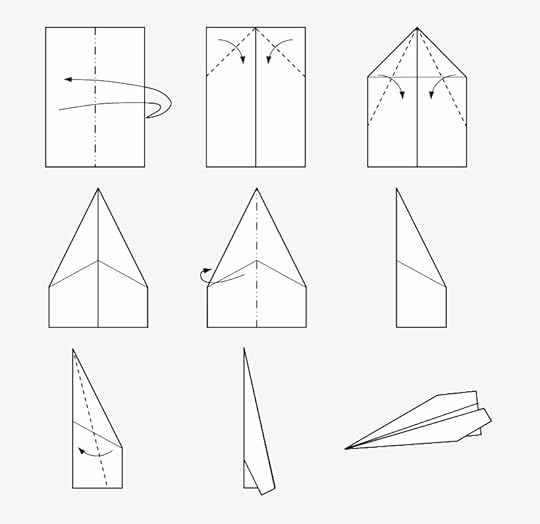
The Wright Brothers first flew at Kitty Hawk in 1903. Paper airplanes began to be made only several years afterwards.
And yet, any child can make a paper airplane. The Chinese invented paper 2000 years ago and had kites. Birds have been flying since dinosaur times, and humanity has dreamed of flying since the stone age. Paper models of sailing ships, hot air balloons, and dirigibles were available before 1903. Japanese origami had already reached wonderful sophistication. Nothing was stopping anyone from making a paper airplane.
Except one thing: no one knew what an airplane looked like or how it would work. No one could imagine it. Orville and Wilbur had to develop an accurate understanding of how wing shape affected air pressure and created lift in order to make a real airplane, and by 1899 they had built intricate gliders and harnessed wind power. Their discoveries would eventually be transferred to a simplified three-dimensional paper model. The rest is history.
This leaves me sitting here staring at a sheet of paper, wondering what unprecedented things it could do, things that would delight any child, if we could only imagine them.
February 6, 2025
“Sentient Plants, Artificial Intelligence, and Fippokats”
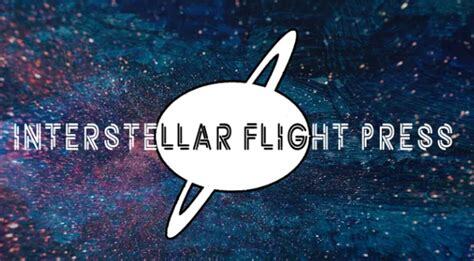
Alex Kingsley has interviewed me about the Semiosis trilogy for Interstellar Flight Magazine. You can read the interview here.
Alex asked: In Usurpation, there’s a pandemic. Was this pandemic inspired by our real-life pandemic? How did COVID-19 affect your portrayal?
I answered: In the 1980s, I was covering HIV as a journalist, and one day before a meeting, I was chatting with the Wisconsin state epidemiologist. He explained that while AIDs was awful — and as a gay man, he knew exactly how terrifying and destructive it was — a different new disease could be a lot worse. He described the many ways in which it could be easier to transmit, harder to detect, more resistant to treatment, and more deadly. COVID wasn’t my first pandemic, it wasn’t the worst, and it wasn’t at all inspiring.
February 3, 2025
I’ll be at the Brookfield Library on Wednesday – and some translation news

I’ll be at the Sci-Fi & Fantasy Book Club at Linda Sokol Francis Public Library in Brookfield, Illinois, at 7 p.m. Wednesday, February 5. We’ll discuss the novel Dual Memory.
New participants are welcome!

More news: I translated the short story “Bodyhoppers” by Rocío Vega for the February 2025 issue of Clarkesworld Science Fiction & Fantasy Magazine. Read it here.
***
The story I translated for Clarkesworld Magazine last year, “The Coffee Machine” by Celia Corral-Vázquez, is a finalist for Best Short Story of 2024. More information is here.
January 29, 2025
I’ll be at Capricon 45
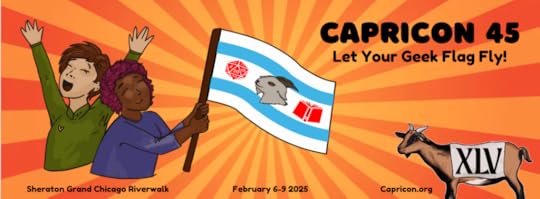
From anime to video games, science fiction to Dungeons & Dragons, and mainstream comic book movies, we live in the age of the geek. Capricon 45 will celebrate dorks, nerds, and geeks with the theme “Let your geek flag fly” at the Sheraton Grand Chicago Riverwalk hotel from February 6 to 9, 2025.
Capricon is a four-day science fiction convention held annually in the Chicagoland area since 1981. It celebrates science fiction and fantasy with a focus on literature. As part of the world-wide fannish community, diversity is encouraged and all are welcome. The convention is created and run entirely by volunteers, so this is a non-commercial gathering of about a thousand friends and friends-to-be.
During the day, members attend programming on a variety of topics: books, movies, television, anime, space exploration, and science. There’s a special children’s track and a teen lounge. Say hello to the mascot, Capricious the goat. Visit the dealer’s room, see the art show and auction, get into gaming, filk, or party all night long. You can still register to attend.
Here’s where you can find me:
Speculative Literature Foundation Deep Dish Reading — Bridgeport Room, Friday 5:30 p.m. to 6:30 p.m. Scheduled readers will be followed by an open mic. Moderator Mary Anne Mohanraj; Shaun Duke, Sue Burke, Richard Chwedyk, K.M. Herkes, Angeli Primlani, Llewella Forgie.
What’s Hot in Speculative Poetry? — Bridgeport Room, Saturday 10:00 a.m. to 11:00 a.m. Speculative Poetry is having a moment. Former Capricon guest of honor Brandon O’Brien writes spec-po. At this year’s Worldcon in Seattle, he is behind a Special Hugo Award category for Speculative Poetry. Where should you start exploring this genre? Moderator Brandon O’Brien; Mary Turzillo, Sue Burke, Brian U. Garrison.
Geeky Gardening — Bridgeport Room, Saturday 11:30 a.m. to 12:30 p.m. How to grow weird, wonderful plants for the backyard, balcony, or windowsill. Moderator K.M. Herkes; Kim Kofmel, Sue Burke.
Living in Space — Sheraton III Ballroom, Saturday 2:30 p.m. to 3:30 p.m. So you want to live in space. Permanently. Raise your kids there and eventually age and die there. Never see a gravity well again. What will it be like? How will your habitat generate centrifugal gravity? Or would it be better to float free, with no gravity at all? What about trade with other habitats, asteroids, and planets? What will your society and government be like? The possibilities are endless! Moderator Sue Burke; Henry Spencer, Thomas Barclay, Jeffrey Liss.
Putting the “Science” in Science Fiction — Columbus Room, Saturday 5:30 p.m. to 6:30 p.m. Some authors have technical knowledge, others do not. Learn from science fiction authors as they talk about what to research, how to research, and what, if anything, you can fudge for the sake of story. Moderator Sue Burke; Brian U. Garrison, Jonathan Brazee, Geoffrey A. Landis, K.V. Peck.
Generation Ship Economics — Gold Coast Room, Sunday 1:00 p.m. to 2:00 p.m. What does a generation ship need to keep its humans alive? Who’s going to pay for everything at the beginning, and what economic systems may develop onboard and at their destination? Moderator Sue Burke; Geoffrey A. Landis, Jeffrey Liss, Thomas Barclay.
January 20, 2025
I’ll be on a TBRCon panel Jan. 22: Is Science Catching Up to What Was Once SciFi?
The FanFiAddict website is back with TBRCon2025, an all-virtual sci-fi/fantasy/horror convention that will livestream from January 19 to 26. More than 150 authors, podcasters, bloggers, and booktubers will appear on the virtual stage for 25 livestream panels, 5 live podcasts and 2 RPG sessions.
TBRCon2025 is free to watch, available on YouTube, Bluesky, X, and Threads during convention week — or to re-watch on YouTube at your convenience.
I’ll be on the panel “Is Science Catching Up to What Was Once Sci-fi?” on Wednesday, January 22, from 10 a.m. to 11:30 a.m. CST, with Mary Robinette Kowal, Malka Older, and Wick Welker, moderated by Neil Williams. A lot has changed in recent years when it comes to technology. But are we at full sci-fi tech level yet?
You can watch it live on YouTube here:
Some other panels I want to see: What Makes a Great Prologue? – Artificial Intelligence in Sci-Fi Over the Years – Space Horror: Monsters in Zero Gravity – How Book Illustrations Come to Life – What Is the Future of Dystopian Sci-Fi? – What Writing Advice Do You Take and What Do You Leave Behind? – Sci-Fi Tropes That Need an Update – How to Market Through Email Newsletters: Do’s and Don’ts.

January 15, 2025
A book I translated, now on sale: ChloroPhilia

Written by award-winning author Cristina Jurado, ChloroPhilia tells the story of Kirmen. He’s different from the other inhabitants of the Cloister, whose walls protect them all from the endless storm ravaging Earth. As a result of the Doctor’s cruel experiments, his physical form is gradually evolving into something better fit for survival in the world outside. This singular coming-of-age story addresses life after an environmental disaster and collective madness, and ends with surprising triumph.
As a translator, I faced a particular challenge with the prologue and the closing section. I’ve translated Cristina before, and she writes beautifully. She poured her talent into prose soaring toward poetry that needed to be equally compelling in English. I did my best:
And behind it all was the roar of the swarm that was its body, millions of shrieks drowning in the fleshy throats of minute beings, a beautiful song made from the spark that lit their lives and that, doused forever, wove the music of the dead.
You can read an interview with the author at The Madrid Review: New Book From The Queen Of Spanish Sci Fi in English.
The novela was reviewed by the Fantasy-Hive as “a remarkable, powerful and disturbing novella that confirms Jurado as a key creative voice in speculative fiction.”
ChloroPhilia is on sale here or at your favorite bookseller.
January 9, 2025
My works eligible for awards for 2024
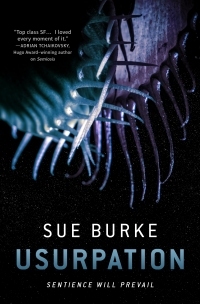
If you or someone you know can nominate or vote for writing awards, please consider these works by me that were published last year:
Usurpation: final novel in a trilogy (novel or series) Semiosis. The first novel in the series, Semiosis, is one of the top ten genre books of the first quarter of the millennium, according to Joe Walton.
AI is fueling a science fiction scam: magazine article (related work)
“The Coffee Machine”: translation from Spanish of a work by Celia Corral-Vázquez (short story or translation)
When Star-Stuff Tells Stories: essay about first contact (related work)
Eligible in Spain:
Semiosis: novela extranjera
¿Quién ganó la batalla de Arsia Mons?: novela corta extranjera
Not eligible for a prize, but you might enjoy it:
“Life from the Sky”: republished novelette
December 31, 2024
Spain’s word of the year, which you weren’t taught in school: dana
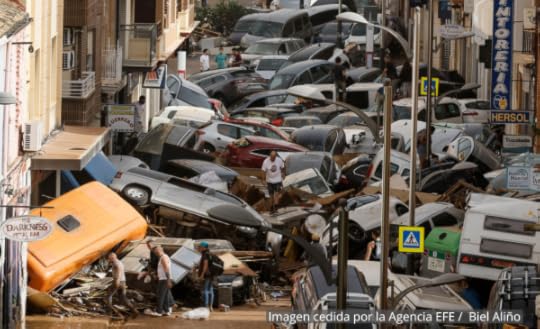
English-language dictionaries and various wordniks have picked their words of 2024, including demure, kakistocracy, enshittification, brat, brain rot, Colesworth, manifest, and polarization.
In Spain, the Fundación del Español Urgente (Foundation for Urgent Spanish) was created by the Spanish Royal Academy and EFE, a news agency, to provide guidance for terminology used in the news media that might pose problems in grammar, meaning, or spelling. It also chooses a word of the year. This year the word is: dana.
Even if you know Spanish, you may have never heard of this word. It’s fairly new, formed by the acronym for depresión aislada in niveles altos (isolated depression at high levels). The World Meteorological Organization explains that it “often occurs during the autumn season because the remaining warm surface heat from summer meets a sudden cold invasion aloft from the polar regions. This leads to what meteorologists used to call ‘a cut-off system’ with low-pressure values that persist over a few days and rotating over the concerned region.” Warm air saturated with moisture meets cold air and becomes an intense, long-lasting storm.
In Valencia at the end of October, the result was devastating rainfall and horrific flash floods. More than 200 people died amid massive damage. There were big political consequences. Dana is Spain’s word of the year because of its importance.
Other candidates for Spain’s word of the year can tell us more about the year that was in that corner of the globe:
Fango (mud or slime): what the victims of the dana had to clean up — and what they hurled at politicians.
Inquiokupa: renters of apartments or homes who stop paying the rent intentionally and refuse to move out. Spain has a housing crisis, too. This, like dana, is a neologism.
Micropiso (micro-apartment): another newish housing-crisis word.
Mena: an acronym for menores extranjeros no acompañados (unaccompanied foreign minors), a newish term because Spain has immigration issues, too.
Narcolancha (narco-speedboat): a newish word invented because Spain has a drug-smuggling problem, too.
Pellet (pellet, also called nurdle in English): a word imported from English to describe the millions of tiny balls of raw-material plastic that washed up on Spain’s west coast in January.
Alucinación (hallucination): errors invented by AIs; as in English, a new meaning has been attached to an existing term.
Gordofobia (fat-fobia): a newish word for a world-wide phenomenon.
Reduflación (shrinkflation): another new word for what happens when the price stays the same but the product becomes smaller, another world-wide phenomenon.
Turistificación (touristification): a problem in many places, including Spain, especially Barcelona.
Woke (woke): another word imported from English, but it’s pronounced with two syllables, WOH-kay.
December 24, 2024
The best Christmas tree ever
My sister, Beth, died in January 2014 of cancer. Her last Christmas was one of her happiest.
In December, Beth’s son and his wife came to visit, and they set up and decorated the tree. Beth had inherited the Christmas tree ornaments from my parents and grandparents, and although she was too ill to do more than watch them work, she was entranced. It was, my sister said, the best tree ever.
She described it to me over the phone (I had visited at Thanksgiving), and I could see it as she spoke because I knew so many of the ornaments.
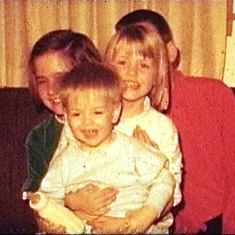 Photo: The four Burke kids on Christmas Eve, captured from one of our grandfather’s home movies. Beth is the blond. I’m wearing green. Lou is the baby. Mike is in back.
Photo: The four Burke kids on Christmas Eve, captured from one of our grandfather’s home movies. Beth is the blond. I’m wearing green. Lou is the baby. Mike is in back.My mother had made a canvas-work embroidery angel for the top of the tree. In keeping with family tradition, a little electric candle had been placed in her hands.
Some old, fancy glass ornaments had originally been bought by my grandparents, lovingly cared for by my parents and then by Beth. They were fragile and worn but exceptionally ornate. One had gold stripes edged with glitter and little holiday scenes hand-painted between the stripes.
My sister especially loved the ornament her son had made in grade school, a white paper bird with a long tinsel tail. There was also my ornament from kindergarten, green and red metallic disks glued together around a length of yarn. Other children’s artwork was hung up, too, chronicling a family that grew larger, and boys and girls who grew up. Some ornaments were gifts or careful purchases — each color, each sparkle, each light a story.
“It’s beautiful,” she told me. “I can stare at it for hours.”
It held happy memories from her whole life, as merry as a Christmas tree could be — the best gift, the best tree ever.



